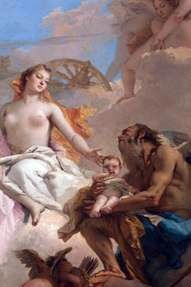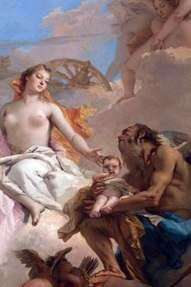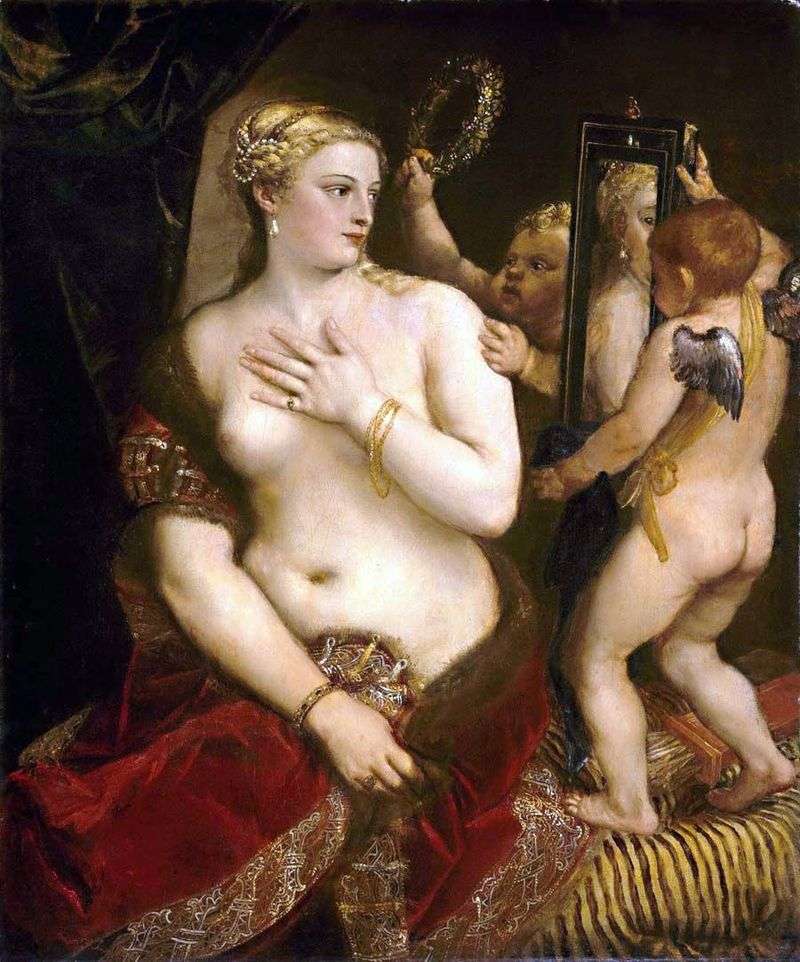
This picture was ordered by Tiepolo’s wife Contarini on the occasion of the birth of their long-awaited firstborn heir. Therefore, it is not surprising that the center of the composition of “Allegory” is a baby. He is held in the hands of Kronos, personifying the wise and inexorable Time. The terrible “tool of labor” of Kronos – a scythe – is put aside. The beautiful goddess Venus, sitting on the clouds, gently touches the head of the child with her hand. Judging by how graciously the goddess gazes at him, how carefully he holds it in the arms of Kronos, this is the only mortal son of Venus, Aeneas. Hence, from Allegory, the happy parents of Contarini should have realized that their son was destined for the same glorious fate as the legendary Aeneas.
Behind Venus are her three eternal companions, Gracia. They shower the baby with pink petals and release pigeons into the sky. In the foreground, at the feet of Time, the beloved son of the goddess hides in the shade, Cupid. Aphrodite, one of the most famous goddesses of the Greek pantheon, was loving. The fruit of one of her love affairs was Aeneas, the hero of the Trojan War. According to legend, Aphrodite saw Anchis when he herded flocks in the vicinity of Mount Ida. The goddess was captivated by his beauty and, posing as the daughter of Phrygian king Othrey, fell in love with him. A little later she discovered to Ankhis that she would bear Aeneas’ son, but forbade him to disclose the secret of their marriage.
However, Anhis violated the ban and told his friends about it, hopping during the banquet. For this Zeus struck him with lightning. Aeneas was the only son of Aphrodite, born of a mortal. Up to five years the boy was brought up by mountain nymphs. In the Iliad, Aeneas is mentioned among the most glorious heroes of Troy. The brave warrior, he nevertheless was defeated in decisive duels with Achilles and Diomedes and avoided death only thanks to the intervention of his immortal mother, Apollo and Poseidon. The further life of Aeneas is full of wanderings. If you believe Virgil’s Aeneid, Aeneas left Troy on the very last night before her fall. The gods ordered him to leave the city, taking with him the old father of Ankhis and the young son of Askania. On twenty ships Aeneas and his companions set off to find a new homeland. Anhis died on the road and was buried by Aeneas in Sicily.
Most of the companions of Aeneas perished, and he himself was abandoned to Carthage. Here, the queen of Dido, who fell in love with him at first sight, greeted him affectionately. In Carthage Aeneas spent quite a lot of time, held by Dido’s love. But the voice of the gods still commanded him to swim further, and Aeneas came on the road. Soon he reached the city of Kuma on the Italian coast. Kumekaya sibyla predicted Aeneas his fate, as well as the fate of his descendants. Next, Aeneas was waiting for a meeting with Aavinia and her father Latina, the local king. Latin agreed to give Aavinia to Aeneas’ wife, but before that he had to defeat the leader of the local tribe of Rutul, who also claimed the hand of the tsar’s daughter.
Aeneas, of course, won and married the beautiful Lavinia. The Italian land became the successor to the glory of Troy. The old man The time that holds the baby Aeneas in his arms is none other than Kronos, Titan, Zeus’s father. Subsequently, Kronos merged with the “Chronos”. Kros Kronos-Chronos received from his Roman counterpart Saturn, personifying the inexorable run of time. There is another myth related to Kronos. On it Kronos ruled “the islands of the blessed”; the time of his reign was the “Golden Age”.
Probably, Tiepolo knew about this myth and, portraying the little Contarini in the image of Aeneas, and even in the hands of Kronos, wished him not only the glorious feats of the Trojan hero, but also a happy life under the tutelage of the ruler of the “islands of the blessed.” Sometimes Venus is portrayed in a chariot drawn by a flock of pigeons, but in this case the pigeons flutter freely. They hover in the sky, above the head of the goddess and baby, lying in the arms of Time. Their united beaks, like a kiss, and their winged wings form a resemblance to a halo over Venus and a child. This complex detail demonstrates Tiepolo’s unsurpassed technical prowess. Pigeons seem to be written with one easy brush movement, and after all, like all the other elements of the picture, they are shown in a very uneasy for the artist perspective.
Not many painters were able to do this – and even more admirable is Tiepolo’s work. The artist skillfully pushes the boundaries of space and creates on the canvas the illusion of the vast heavenly space above the viewer’s head. It is this kind of illusions that made Tiepolo the glory of the best fresco master of the 18th century, the successor of the tradition of Michelangelo and Raphael.
 Allégorie avec Vénus et le temps – Giovanni Battista Tiepolo
Allégorie avec Vénus et le temps – Giovanni Battista Tiepolo Venus and the Volcano with weapons for Aeneas by Francois Boucher
Venus and the Volcano with weapons for Aeneas by Francois Boucher Alegoría con Venus y el tiempo – Giovanni Battista Tiepolo
Alegoría con Venus y el tiempo – Giovanni Battista Tiepolo Venus with a mirror by Titian Vecellio
Venus with a mirror by Titian Vecellio Alexander the Great and Diogenes by Giovanni Battista Tiepolo
Alexander the Great and Diogenes by Giovanni Battista Tiepolo Euribat and Talfbiy, leading Briseid to Agamemnon by Giovanni Battista Tiepolo
Euribat and Talfbiy, leading Briseid to Agamemnon by Giovanni Battista Tiepolo Venus in the forge of Vulcan by Francois Boucher
Venus in the forge of Vulcan by Francois Boucher Triumph of Flora by Giovanni Battista Tiepolo
Triumph of Flora by Giovanni Battista Tiepolo